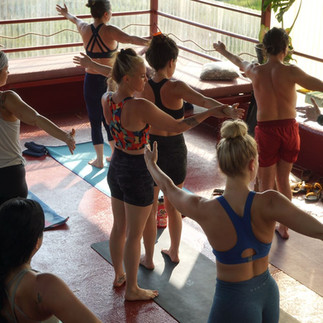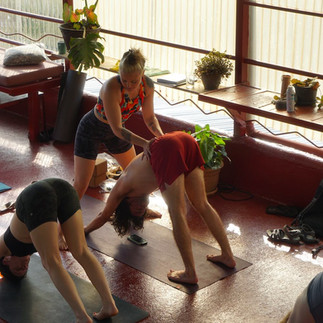How to choose the right Yoga Teacher Training in Costa Rica?
- Aurélise Leroux

- Sep 24, 2025
- 7 min read
Costa Rica has become a premier destination for yoga teacher training (YTT), thanks to its natural beauty, wellness culture, and “Pura Vida” lifestyle. But with so many programs to choose from, how do you decide which one is right for you?
In this article, we’ll go through the most important factors to consider, what questions to ask, and how to find a training that aligns with your goals. If you’re already considering programs, one resource to check out is our Yoga Teacher Training in Costa Rica page, where you’ll find detailed information, options, dates, and what to expect.

Why do a yoga teacher training in Costa Rica?
Before we dive into how to choose, it’s worth reviewing why Costa Rica is such a favorite for YTTs:
Natural environment: Beach, jungle, volcanoes – the lush scenery lends itself to meditation, inward focus, and resetting daily routines.
Wellness culture: There is a strong existing infrastructure for retreats, healthy eating, holistic healing practices, etc.
Accessibility: It’s relatively easy to travel there from many parts of the U.S., Canada, and Europe, and once you're in Costa Rica you're often not too far from tropical nature.
Lifestyle: The slower pace, connection to nature, possibility for unplugging, simplicity – all of these are a draw if you want your YTT also to be a personal growth experience.
Key Factors to Consider When Choosing Your Yoga Teacher Training
Here are the criteria that matter most. Use this as a checklist when comparing programs.
Factor | Why it’s Important | What to Ask / Look For |
Accreditation & Certification | Ensures your training is recognized (e.g. by Yoga Alliance), that the syllabus meets standards, that your certification is accepted. | Is the program Yoga Alliance certified (or equivalent)? What level (200-hour, 300-hour, etc.)? Are there options for continuing education? How many “contact hours,” etc.? |
Curriculum & Style | Different styles emphasize different things (asanas, alignment, flow, restorative, yin, etc.). The content beyond physical practice (philosophy, anatomy, meditation, pranayama) shapes the depth and kind of training you receive. | What yoga styles are taught? How much time is allocated to each component (asana, philosophy, anatomy, teaching methodology)? Are there special or unique offerings (spiritual, energy work, Ayurveda, etc.)? |
Teacher & Teaching Staff | The lead trainers influence your experience a lot. You’ll want someone experienced, approachable, aligned with your values. | What are their credentials? How many years of teaching? Do they mentor personally? Is there more than one teacher or support staff/assistants? Can you see reviews, speak with former students? |
Duration & Structure | Some trainings are very intense over a few weeks; others more spread out. The structure affects how well you can absorb the material, rest, integrate, etc. | How many days/weeks is the training? What is the daily schedule like (hours of practice vs rest)? Is it fully in-person, hybrid, or modular? |
Location & Setting | Do you prefer beach, jungle, mountain, remote, more comfortable resort settings, or rustic? The setting can affect how restorative or challenging the retreat is. | What is the retreat center like? What lodging is provided? Is it remote or easy to access? What season will you be there (dry vs wet season)? How about the climate, potential travel within Costa Rica? |
Group Size | In small groups, you often receive more personalized attention; in larger ones, there’s more diversity and energy, but possibly less one-on-one interaction. | What is the maximum number of participants? What is the student-teacher ratio? How many assistants are there? Are there shared vs private lodging options? |
Price & What’s Included | Price doesn’t just mean tuition – lodging, meals, travel, excursions, extra materials, and sometimes airport transfers may or may not be included. | What is the total cost? What’s included (food, lodging, materials, certification, local transport)? What’s not included? Are there scholarships or payment plans? What is refund policy? |
Daily Schedule & Pace | Balancing practice, rest, personal time, excursions, and integration is key. Over-ambitious schedules may leave you burnt out. | Ask to see a sample daily schedule. How much downtime is built in? Are there excursions or free days? Is there flexibility if you need rest? How does the program support reflection, journaling, and meditation? |
Food, Accommodations, Logistics | Comfort, safety, nutrition, and good lodging help you focus; poor arrangements can distract or detract. | What are lodging standards (shared/private, bathrooms, amenities)? What food is provided? How do they handle dietary restrictions? How far is the location from airports / how are transfers dealt with? What are the climate and mosquito/bug/health considerations? |
Reviews, Alumni Experiences, Safety & Health | Hearing others’ experiences can give you insight into what to expect in reality. Also important in unfamiliar places: health standards, safety, and insurance. | Can you read reviews (both positive and negative)? Talk to past students if possible. What about safety: access to clean water, medical care, and emergency procedures? What’s the policy for injuries or illness? Are there any health/vaccination recommendations? |
What questions should you ask (and how to evaluate the answers)?
To help you apply the above, here are questions to ask when talking to the organizers or reading their information, plus what “good answers” might look like.
Question | What to Listen for / Good Signs | Red Flags |
“Is the training certified and recognized?” | They clearly state that they are affiliated with Yoga Alliance or an equivalent, display their credentials, and demonstrate how many hours or sequences meet the standards. | Vague claims, such as “we teach you everything you need,” without specific details; no evidence of accreditation. |
“Who are the teachers?” | Bios with training, years teaching, maybe student testimonials; clarity on who leads vs supports. | Just listing names without qualifications or a lack of clarity. |
“What’s included, and what’s the real total cost?” | Transparent lists: lodging, meals, materials, excursions, and airport transfers if relevant. Clear cancellation/refund policy. | Fine print with hidden costs; vague about food, transport, and lodging. |
“What will the daily schedule be like?” | Sample schedule that shows balance: physical practice, philosophy/lectures/anatomy, personal time, rest. Realistic hours (not overly packed). | Overloaded days, 5-6 am start every day without a break, lack of rest, and no free time. |
“How many students per teacher/assistant?” | A number; ensure that you will get feedback; a small group or sufficient support staff. | Very large classes, unclear support staff. |
“How is food handled?” | Local, fresh, healthy; options for dietary restrictions; enough nourishment for physically demanding days. | Food is overly basic or repetitive; not much attention to diet; inability to accommodate allergies. |
“What’s the location like?” | Good lodging, safe, comfortable; accessibility; beautiful surroundings; weather considerations; how remote or connected. | Inaccessible, unsafe, very remote without proper support; lodging that seems cheaply done; very rustic without comfort. |
Considering Your Personal Goals & Priorities
Since each person’s goals differ, it helps to clarify your priorities before choosing.
What matters most to you?
Are you primarily seeking a certification to teach professionally?
Or is this more of a personal growth / spiritual journey?
How much physical practice do you want vs more emphasis on meditation/breath/philosophy?
Do you prefer a luxurious setting, or are you okay with rustic / “bare-bones” if the training is authentic?
How much time can you take off? Do you need a shorter or longer program?
What is your budget, including travel & hidden costs?
Pitfalls & What to Watch Out For
To help you avoid unpleasant surprises, here are some “watch-outs”:
Too cheap to be true: Sometimes, very low cost means corners are cut (lodging, food, teacher quality).
Overhyped marketing: Beautiful photos, Instagram-perfect settings, but actual infrastructure, safety, or program quality may be lacking.
Lack of transparency: Hidden fees, vague accommodation descriptions, unclear cancellation policies.
Burnout risk: Overpacking the schedule, not enough rest, and travel fatigue.
Health & safety: Location in remote areas might mean limited medical access; risk of insect‐borne issues; water quality; climate extremes.
Sample comparison: what Good vs. great looks like
To illustrate, here are sketches of what a good YTT vs a great YTT might look like, using hypothetical comparisons in Costa Rica.
Good:
200-hour training,
Yoga Alliance certified;
Location in the jungle lodge;
Shared rooms; Meals included;
Teacher with 5-10 years of experience;
Class size 20-25;
Schedule from 6-7 am yoga,
Lectures in the afternoon,
Rest in the evening;
Price moderate.
Great:
Same cert;
Lead teacher + assistant(s) with decades of experience;
Student-teacher ratio small (≤ 15);
Curriculum includes strong anatomy, philosophy, meditation/pranayama, optional special modules (Ayurveda/energy work);
Lodging in comfortable (private or premium shared options),
Meals are organic, able to accommodate allergies;
The setting is beautiful and restorative.
Downtime built in.
Includes transport from airport or airport pickup; g
Good alumni support;
Real reviews;
Transparent pricing.
How to use “Costa Rica” to your advantage?
Costa Rica offers some unique features — you can use them to enhance your experience, but also to decide what you’re willing to trade off on.
Seasonality: Dry season (roughly December – April) tends to be more comfortable; wet season can be rainforest-lush but also muddy, with more insects.
Remote vs Accessible: A remote location is magical but may require more travel (roads, small planes, boats), adding cost & time.
Natural setting as teacher: Use the environment — beaches, jungle, wildlife — as part of the training: meditation outdoors, walking in nature, etc. Some trainings incorporate eco-awareness, sustainability.
Cost of living & extras: Costa Rica is not the cheapest destination; even once you’re there, you’ll spend on travel inside the country, gear, local transport, and souvenirs. Make sure that’s factored in.
How does our Program meet these criteria?
If you’re considering programs, we believe ours at Pura Vida Traveling hits many of the marks.
On our Yoga Teacher Training Costa Rica page, you can see:
Full transparency around what’s included inthe cost — lodging, meals, materials, certification.
Experienced instructors with a strong background, able to mentor personally.
Beautiful settings that integrate nature, comfort, and wellness.
Student group sizes that allow for individual attention.
Balanced curriculum: asana, philosophy, meditation, pranayama, anatomy, teaching methodology, and integration time.
Support in logistics, including travel to/from the retreat center.
If these are the things you value, it may be a strong fit for you.
Final Thoughts
Choosing the “right” yoga teacher training in Costa Rica is a deeply personal decision. What’s right for someone else may not be ideal for you. By clarifying your priorities (certification, style, setting, price, rest vs intensity, etc.), asking good questions, reading real reports, and comparing details, you’ll be able to choose a training that both transforms you and gives you the teaching tools you want.
If you’d like, I can send you a curated list of top YTT programs in Costa Rica that match your specific goals (style, budget, duration) to make comparison easier. Would you prefer that?










Comments